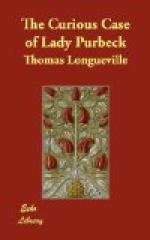It will be remembered that even when Lady Purbeck was being proceeded against for unfaithfulness to her husband, at the instigation of Buckingham, she was on friendly terms with Lord Purbeck, and that Buckingham had considerable difficulty in keeping them apart: consequently it is the less to be wondered at that Lord Purbeck “took his wife again,” after her return from exile. Not only was Lady Purbeck now a reformed character, but, like Lord Purbeck, she was a convert to the Catholic Church; and this would probably make him the more inclined to receive her again as his wife and to trust her for the future. At the time of their reunion Lady Purbeck must have been about forty, and he must have been an oldish man; although not too old to be a bridegroom, and no longer under suspicion of insanity; for, in addition to starting a second time as husband to Frances, Lady Purbeck, it is recorded that after her death, which occurred in five or six years, he married again,[102] and survived his first wife by twelve years.
If the beginning of married life a second time, after an interval of sixteen years—to say nothing of certain awkward incidents which had transpired in the meantime—may have been a little out of the common, it is more remarkable still that Lord Purbeck should have acknowledged the boy, Robert Wright, as his son. As was shown in an earlier chapter, it is just possible that he may have been ignorant of the fact that the lad was not his own child, or rather, perhaps, that he refused to believe in that fact. On the other hand, as the boy was born in wedlock, he had in any case the right to acknowledge him as such, if he so pleased. That was his concern, not ours, so we need not cavil at it.
His doing so may be accounted for by either of the two following suppositions: namely, that he acknowledged the boy out of affection for, and to please, his wife—possibly it may have been one of the inducements held out to persuade her to return to him—or that he gradually took a fancy to the lad and chose this method of adopting him. Whatever the cause of his acknowledging the boy may have been, that acknowledgment encourages the idea that good relations existed between Lord and Lady Purbeck after what may almost be called their second marriage, or, perhaps still better called, their first real marriage with consent on both sides.
Purbeck called the boy Robert Villiers, and would not allow him to be spoken of as Robert Wright. When the lad came of age, Lord Purbeck made him join with himself, as his son and heir, in the conveyance of some lands, under the name of Robert Villiers,[103] the most formal of legal recognitions.




